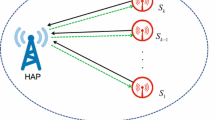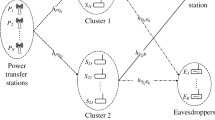Abstract
This article presents a performance analysis of wireless energy harvesting (WEH)-enabled sensor networks that extract energy from ambient radio frequency (RF) signals prior to uplink transmission. A time-switching (TS)-based protocol is utilized to alternate sensor nodes between energy harvesting (EH) and data transmission modes. Implementing the non-orthogonal multiple access (NOMA) technique aims to boost the sensor network’s performance regarding uplink sum rate and outage probability. To optimize resource allocation, we propose an unequal operating time frame (OTF) scheme that determines data transmission and energy harvesting intervals based on channel gain quality. Simulation results affirm the superiority of NOMA over orthogonal multiple access (OMA), with NOMA enabling higher sum rates by accommodating more signals within the same frequency band, though at the expense of slightly degraded outage performance.





Similar content being viewed by others
Data Availability
No datasets were generated or analysed during the current study.
References
Kamalinejad P, Mahapatra C, Sheng Z, Mirabbasi S, Leung VC, Guan YL (2015) Wireless energy harvesting for the internet of things. IEEE Commun Mag 53(6):102–108
Ma D, Lan G, Hassan M, Hu W, Das SK (2019) Sensing, computing, and communications for energy harvesting iots: A survey. IEEE Communications Surveys & Tutorials 22(2):1222–1250
Singh J, Kaur R, Singh D (2021) Energy harvesting in wireless sensor networks: A taxonomic survey. Int J Energy Res 45(1):118–140
Zhu Z, Huang S, Chu Z, Zhou F, Zhang D, Lee I (2018) Robust designs of beamforming and power splitting for distributed antenna systems with wireless energy harvesting. IEEE Syst J 13(1):30–41
Singh V, Ochiai H (2017) An efficient time switching protocol with adaptive power splitting for wireless energy harvesting relay networks. In: 2017 IEEE 85th Vehicular technology conference (VTC Spring), IEEE, pp 1–5
Nirati M, Oruganti A, Bepari D (2020) Power allocation in wireless energy harvesting based relaying sensor networks. In: 2019 4th International conference on recent trends on electronics, information, communication & technology (RTEICT), pp 491–495
Ponnimbaduge Perera TD, Jayakody DNK, Sharma SK, Chatzinotas S, Li J (2018) Simultaneous wireless information and power transfer (swipt): Recent advances and future challenges. IEEE Communications Surveys & tutorials 20(1), 264–302. https://doi.org/10.1109/COMST.2017.2783901
Bepari D, Mondal S, Chandra A, Shukla R, Liu Y, Guizani M, Nallanathan A (2023) A survey on applications of cache-aided noma. IEEE Commun Surv & Tutorials
Bepari D, Misra A, Mondal S, Bala I (2023) Partial cooperative noma for improving outage performance of edge users. Int J Electron Lett pp 1–18
Ramesh Chandra K, Borugadda S (2022) An effective combination of terahertz band noma and mimo system for power efficiency enhancement. Int J Commun Syst 35(11):5187
Chandra KR, Borugadda S (2023) Multi agent deep reinforcement learning with deep q-network based energy efficiency and resource allocation in noma wireless systems. In: 2023 Second international conference on electrical, electronics, information and communication technologies (ICEEICT), IEEE, pp 1–8
Chandra KR, Borugadda S (2023) Joint resource allocation and power allocation scheme for mimo assisted noma system. Transactions on Emerging Telecommunications Technologies 34(7):4794
Gangadhar C, Chanthirasekaran K, Chandra KR, Sharma A, Thangamani M, Kumar PS (2022) An energy efficient NOMA-based spectrum sharing techniques for cell-free massive MIMO. International Journal of Engineering Systems Modelling and Simulation 13(4):284–288
Wang X, Na Z, Lam K-Y, Liu X, Gao Z, Li F, Wang L (2019) Energy efficiency optimization for noma-based cognitive radio with energy harvesting. IEEE access 7:139172–139180
Azarhava H, Niya JM (2020) Energy efficient resource allocation in wireless energy harvesting sensor networks. IEEE Wireless Communications Letters 9(7):1000–1003
Nasir AA, Tuan HD, Duong TQ, Debbah M (2019) Noma throughput and energy efficiency in energy harvesting enabled networks. IEEE Trans Commun 67(9):6499–6511
Tran HQ, Nguyen T-T, Phan CV, Vien Q-T (2019) Power-splitting relaying protocol for wireless energy harvesting and information processing in noma systems. IET Commun 13(14):2132–2140
Barhumi I, Al-Tous H (2021) Optimal power management in energy-harvesting noma-enabled wsns. IEEE Internet Things J 9(7):4907–4916
So-In C, Tran D-D, Tran H et al (2019) Optimal system performance in multihop energy harvesting wsns using cooperative noma and friendly jammers. IEEE Access 7:125494–125510
Rauniyar A, Engelstad PE, Østerbø ON (2019) Performance analysis of rf energy harvesting and information transmission based on noma with interfering signal for iot relay systems. IEEE Sens J 19(17):7668–7682
Wang D, Men S (2018) Secure energy efficiency for noma based cognitive radio networks with nonlinear energy harvesting. IEEE Access 6:62707–62716
Agrawal K, Jee A, Prakriya S (2023) Performance of a multiuser cooperative iot noma network with battery-assisted energy harvesting. IEEE Trans Indust Inform
Vo VN, Nguyen TG, So-In C, Tran H (2020) Outage performance analysis of energy harvesting wireless sensor networks for noma transmissions. Mobile networks and Applications 25:23–41
Pourmohammad Abdollahi M, Musevi Niya J, Mohassel Feghhi M (2023) On the outage performance of energy harvesting noma-based simultaneous cooperate and transmit iot networks. J Ambient Intell Humaniz Comput 14(6):6423–6433
Bepari D, Mondal S, Pareek P, Gupta N (2023) Optimal time splitting in wireless energy harvesting-enabled sensor networks. In: International conference on cognitive computing and cyber physical systems, Springer, pp 241–252
Essai Ali MH (2021) Deep learning-based pilot-assisted channel state estimator for OFDM systems. IET Commun 15(2):257–264
Raghunatharao D, Prasad TJ, Giri Prasad M (2020) Optimal pilot-based channel estimation in cognitive radio. Wireless Pers Commun 114(4):2801–2819
Bepari D, Misra A, Mondal S, Bala I (2024) Partial cooperative NOMA for improving outage performance of edge users. Int J Electron Lett 12(1):69–86
Mahady IA, Bedeer E, Ikki S, Yanikomeroglu H (2019) Sum-rate maximization of NOMA systems under imperfect successive interference cancellation. IEEE Commun Lett 23(3):474–477
Mondal S, Bepari D, Biswas S (2023) Performance of a multihop cognitive radio network with diversity under imperfect CSI. Int J Electron Lett 11(1):41–54
Funding
This research received no specific funding from any agency, organization, or individual. All expenses were covered by the authors.
Author information
Authors and Affiliations
Contributions
The authors of this research paper have all played a direct role in the research process. Dipen Bepari and Soumen Mondal were responsible for selecting the research topic and conducting the fundamental analysis necessary to plan and execute the study. Soumen Mondal and Prakash Pareek were actively engaged in simulating the result using Matlab software. Dipen Bepari and Nishu Gupta have prepared a literature review along with references. Additionally, all authors contributed to creating a clear and concise written description of the research methods, results, and conclusions, which is presented in the form of this research paper.
Corresponding author
Ethics declarations
Ethical Approval
The authors ensure that the research meets the ethical standards of the scientific community and that it does not harm the participants or animals involved.
Competing interests
The authors declare no competing interests.
Competing interests
No competing interests exist. We declare that we do not have any financial or personal relationships with other people or organizations that could inappropriately influence this work. There are no financial or non-financial competing interests associated with this manuscript.
Additional information
Publisher's Note
Springer Nature remains neutral with regard to jurisdictional claims in published maps and institutional affiliations.
Appendix A Proof of Theorem 1
Appendix A Proof of Theorem 1
the optimization problem formulated in Eq. 8a is solved applying the Lagrangian and KKT methods, where the Lagrangian function can be expressed as
where \(\varvec{\alpha } = [\alpha _1, \alpha _2, \ldots , \alpha _N]\) is the vector of variables, \(\varvec{\lambda } = [\lambda _1, \lambda _2, \ldots , \lambda _N]\) and \(\varvec{\mu } = [\mu _1, \mu _2, \ldots , \mu _N]\) are are symbolized as Lagrange multipliers for Eqs. 8b and 8c, respectively. Now, find the partial derivatives with respect to \(\alpha _i\), \(\lambda _i\), and \(\mu _i\) and assign them to zero
To determine the values of \(\alpha _i\) from \(\frac{\partial L}{\partial \alpha _i}\), it’s essential to ascertain the Lagrange multipliers \(\lambda _i\) and \(\mu _i\). This process typically involves iterative techniques like gradient descent or Newton’s method. Alternatively, we can derive \(\alpha _i\) from the Lagrangian’s derivative concerning \(\lambda _i\). Ultimately, the solution for \(\alpha _i\) can be obtained through this method.
Rights and permissions
Springer Nature or its licensor (e.g. a society or other partner) holds exclusive rights to this article under a publishing agreement with the author(s) or other rightsholder(s); author self-archiving of the accepted manuscript version of this article is solely governed by the terms of such publishing agreement and applicable law.
About this article
Cite this article
Bepari, D., Mondal, S., Pareek, P. et al. Uplink Performance Analysis of Wireless Energy Harvesting-Enabled NOMA-based Networks. Mobile Netw Appl 29, 856–866 (2024). https://doi.org/10.1007/s11036-024-02326-8
Accepted:
Published:
Issue Date:
DOI: https://doi.org/10.1007/s11036-024-02326-8




